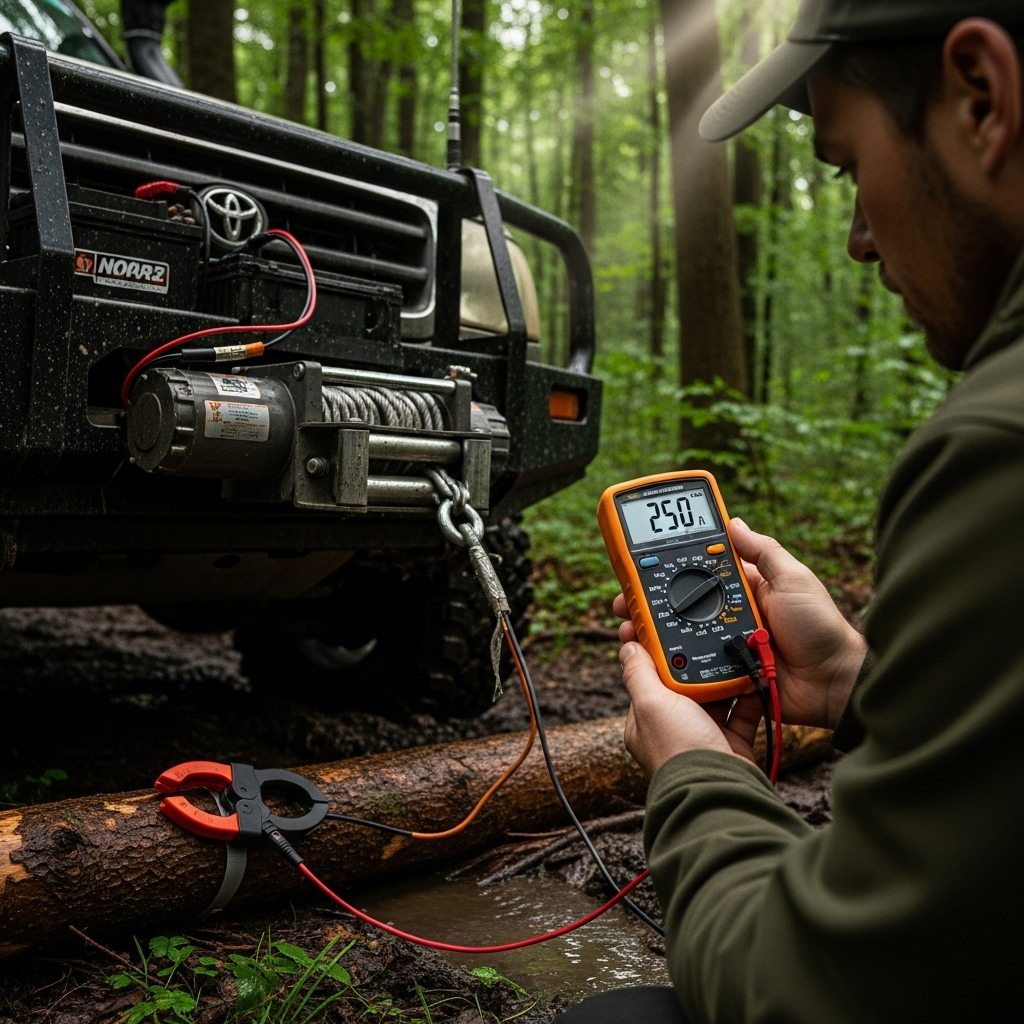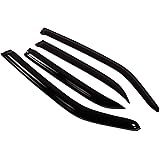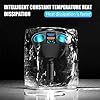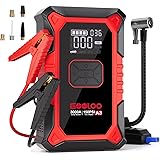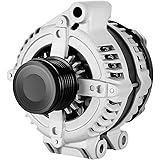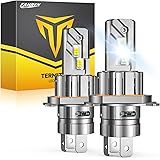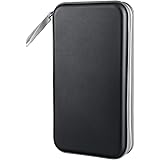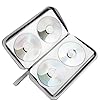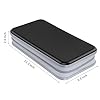Table of Contents
Understanding how many amps does a 12V winch draw is absolutely critical for anyone relying on this powerful recovery tool. It’s the difference between a successful recovery and being left stranded with a damaged electrical system or a dead battery. The simple answer is that a 12V winch’s amp draw is not a fixed number; it varies dramatically based on the load it’s pulling. Under no load, a winch might draw as little as 10-20 amps, but at its maximum rated pull, that number can skyrocket to over 500 amps . This comprehensive guide will demystify winch amp draw, exploring the factors that cause this wide variation, providing real-world data from popular models, and explaining the crucial implications for you
r vehicle’s battery, wiring, and overall electrical health. By the end, you’ll be equipped with the knowledge to use your winch effectively and safely, ensuring it works for you when you need it most.
What is Amp Draw and Why Does it Matter for Your Winch?
In simple terms, amp draw (or current) is the amount of electricity flowing from your battery to the winch motor. Think of it like water flowing through a hose: the water pressure is the voltage (12V), and the amount of water flowing is the amperage. When your winch is working, it’s gulping down electrical power from your battery, and the harder it works, the more it “gulps.”
This concept is vital for several key reasons:
- Battery Health and Longevity: Your battery has a finite capacity, measured in amp-hours (Ah). A high amp draw can quickly deplete this reserve. Consistently drawing high amps without adequate recovery time can permanently damage your battery, reducing its lifespan and its ability to hold a charge .
- Electrical System Safety: Extremely high currents generate significant heat. If your vehicle’s wiring, connectors, or solenoid are not rated for the winch’s maximum potential amp draw, they can overheat, melt, or even cause an electrical fire . Proper wiring is not a suggestion; it’s a safety requirement.
- Performance and Reliability: A winch is only as reliable as the power behind it. If your electrical system cannot deliver the required amps, your winch will perform poorly—slowing down, stalling, or failing completely at the worst possible moment. Knowing the amp draw helps you ensure your entire system is up to the task .
The Key Factors That Determine How Many Amps Your Winch Draws
A winch does not have a single amp rating. Its current draw is dynamic and influenced by several interconnected factors. Understanding these will help you predict your winch’s behavior and electrical demands in different situations.
The Load on the Winch
This is the single most important factor. Amp draw is directly proportional to the load. The heavier the pull, the harder the winch motor has to work, and the more current it demands from the battery .
- No-Load Operation: When the winch is spinning freely without pulling anything, the amp draw is minimal. For example, the Warrior Ninja 3500lb winch draws 45 amps with no load .
- Light Loads: Pulling a vehicle out of shallow mud or up a gentle incline requires moderate power, resulting in a moderate amp draw.
- Heavy and Maximum Loads: Recovering a heavily stuck vehicle or performing a vertical pull places the highest demand on the winch. At its rated capacity, the amp draw will be at its peak. The same Warrior Ninja winch that draws 45A with no load draws 200A at its full 3,500 lb capacity .
Winch Capacity and Motor Power
Larger, more powerful winches are designed to move heavier loads, and they inherently draw more current to do so. A small 2,500 lb ATV winch and a massive 25,000 lb truck winch have vastly different power requirements.
- Motor Horsepower (HP) and Kilowatts (kW): A more powerful motor can draw more current. A simple calculation illustrates this: a 1.9 HP motor can draw approximately 118 amps under full load (1.9 HP * 746 watts/HP / 12V) . In practice, starting current (inrush) can be even higher, potentially around 200A for a motor of this size .
- Rated Line Pull: As a general rule, a higher-rated winch will have a higher maximum amp draw. For instance, a 2,500 lb winch may draw around 160 amps at full load, while a 25,000 lb winch can draw a staggering 530 amps .
Gear Train Efficiency
The planetary gear system inside your winch reduces the motor’s high speed into high torque at the drum. An efficient, well-lubricated gear train reduces mechanical resistance, which in turn reduces the workload on the motor and its amp draw. Worn or poorly maintained gears can increase amp draw.
The Role of the Winch Line
The type and condition of your winch line can also create more or less work for the motor.
- Synthetic vs. Steel Rope: Synthetic rope is significantly lighter than steel cable. This reduced weight means the motor uses less energy to spin the drum and pull the rope out, leading to a slightly lower amp draw, especially noticeable during long pulls .
- Rope Layers on the Drum: This is a critical but often overlooked factor. A winch is strongest and most efficient with only the first layer of rope on the drum. With each additional layer, the effective pulling radius increases, reducing mechanical leverage. This can lead to a 10-15% loss of pulling power per layer . To pull the same load on the fourth layer, the motor must work harder, drawing more amps than it would on the first layer.
Environmental and Operational Conditions
The environment you’re winching in plays a significant role.
- Terrain and Friction: Pulling a load through deep, sticky mud or over rough, abrasive terrain creates immense friction and suction, dramatically increasing the load on the winch and, therefore, the amp draw .
- Battery Charge and Health: A weak or undercharged battery cannot maintain proper voltage under high load. When voltage drops, the winch motor will draw even more amps to try to maintain power (based on the formula: Power (Watts) = Voltage (Volts) × Current (Amps)), creating a vicious cycle that can lead to total system failure.
- Temperature: In cold weather, battery chemistry becomes less efficient, reducing its ability to deliver high current. Additionally, thick lubricants in the winch can increase resistance, slightly raising amp draw until the winch warms up .
Real-World Amp Draw: A Comparative Table of Popular Winches
To move from theory to practice, let’s examine the manufacturer-provided specifications for several winches across different weight classes. This table clearly illustrates the direct relationship between load and amp draw.
Analysis of the Data:
- The Load is King: Notice how the Warrior Ninja 3500 lb winch’s amp draw climbs from 45A (no load) to 200A (full load). This four-fold increase is typical and highlights why you cannot use a single number to describe winch amp draw .
- Capacity Correlates with Max Draw: While not perfectly linear, there is a clear trend. The 2,500 lb winch peaks at 160A, the 3,500 lb at 200A, and the massive 25,000 lb “Beast” tops out at a colossal 530A .
- The Speed vs. Power Trade-off: As the load and amp draw increase, the line speed plummets. The 25,000 lb winch slows to a crawl at 2.6 ft/min under its maximum load, demonstrating the immense strain on the motor .
The Critical Importance of Duty Cycle
You cannot run a winch at its maximum amp draw indefinitely. The duty cycle is the winch’s “work-rest” schedule, and ignoring it is a primary cause of winch failure.
- What is a Duty Cycle? Most winches are designed for intermittent, not continuous, use. A common duty cycle is 1 minute of work followed by 5-10 minutes of rest to allow the motor to cool down .
- Why it Matters: The tremendous amp draw creates intense heat within the motor. Continuous operation causes this heat to build up, which can demagnetize the permanent magnets, degrade insulation, and ultimately destroy the motor.
- Practical Application: If you are making a long, heavy pull, it is wise to pause periodically. If the winch motor becomes too hot to touch, you have already overworked it. Adhering to the duty cycle protects your investment and ensures reliability.
Electrical System Requirements and Calculations
To use your winch safely and effectively, your vehicle’s electrical system must be prepared to handle the high current demands.
Battery Capacity and Health
Your battery is the winch’s power reservoir. For winching applications, a deep-cycle battery is often recommended because it is designed to handle repeated high-current draws and deep discharges better than a standard starting battery.
- Cold Cranking Amps (CCA) and Reserve Capacity (RC): Ensure your battery has a high CCA rating, as this indicates its ability to deliver high current . Reserve Capacity tells you how long it can sustain a medium load.
- Simple Runtime Calculation: You can estimate how long your battery could theoretically power a winch under a specific load. Divide the battery’s amp-hour (Ah) rating by the winch’s amp draw. For example, a 100Ah battery powering a winch drawing 250A would be depleted in roughly 100Ah / 250A = 0.4 hours, or 24 minutes . This is a theoretical maximum; in reality, voltage drop would make the winch unusable long before the battery is fully depleted.
Wiring and Circuit Protection
The wiring between your battery and winch is a critical safety link.
- Wire Gauge: This must be sized to handle the maximum potential amp draw without overheating. For draws exceeding 200 amps, very thick gauge cable (often 2 or 1/0 gauge) is required . Using undersized wiring is a fire hazard.
- To Fuse or Not to Fuse? The main power leads to the winch itself are typically not fused due to the extremely high amperage involved (e.g., 200-500A). Instead, protection is achieved through proper wiring and sometimes a thermal breaker inside the winch . The control circuit for the solenoid, which draws low amps, should be fused. As one expert on a forum noted, “You don’t fuse it… Just make sure the wires are not rubbing against sharp edges” .
The Essential Role of the Alternator
Always run your vehicle’s engine while winching. The battery alone cannot sustain a high amp draw for long. The alternator acts as a continuous power supply, supplementing the battery and preventing it from being completely drained. A powerful alternator will help maintain system voltage, which leads to better winch performance and lower overall amp draw.
Practical Tips to Manage and Reduce Amp Draw
Smart winching techniques can significantly reduce the strain on your winch and electrical system.
- Use a Snatch Block (Pulley): This is the most effective technique. Rigging a snatch block for a double-line pull can effectively halve the amp draw for the same pulling effort. While it slows the pull speed, it dramatically reduces the load on the winch and battery, making it ideal for heavy recoveries .
- Winch from the First Layer: Whenever possible, spool out enough rope so that your pull is done with the first layer of rope on the drum. This provides the greatest mechanical advantage and lowest amp draw .
- Keep Your Battery Charged: Always begin a recovery with a fully charged battery. A low battery will cause poor winch performance and excessively high amp draws.
- Avoid “Powering Out”: Use the free-spool (clutch) feature to release the winch rope rather than “powering out” with the motor. Powering out draws unnecessary current and creates extra heat and wear on the motor.
- Maintain Your Winch: Periodically inspect and lubricate the winch according to the manufacturer’s instructions. A well-maintained winch with clean electrical connections will run more efficiently.
Conclusion
So, how many amps does a 12V winch draw? The definitive answer is: it’s a wide range, entirely dependent on the load. From a modest 20-50 amps while free-spooling to a staggering 200-500-plus amps under maximum load, understanding this dynamic is the key to safe and effective winch operation. It’s not enough to just bolt a winch to your bumper; you must respect its massive power requirements. By choosing the right winch for your vehicle, ensuring your battery and wiring are up to the task, and employing smart techniques like using a snatch block, you harness this power effectively. Remember the duty cycle, always winch with your engine running, and view amp draw not as a mysterious number, but as the vital sign of your winching system. Keeping that current in check ensures that when you’re stuck in a challenging situation, your winch will be the reliable partner that gets you out.
Key Takeaways
- Amp draw is variable: A 12V winch’s current consumption is not fixed; it scales directly with the load, from low amps with no load to very high amps at full capacity .
- Know your winch’s specs: Consult manufacturer data for your specific model’s amp draw at different loads to properly plan your electrical system .
- Respect the duty cycle: Winches are designed for intermittent use. Overheating from continuous operation is a primary cause of failure, so adhere to work/rest cycles .
- Engine on, always: Keep your vehicle’s engine running while winching to prevent draining your battery and to provide a continuous power supply via the alternator.
- Use a snatch block: For heavy pulls, a snatch block can dramatically reduce the load on your winch, thereby lowering amp draw and protecting your electrical system .

